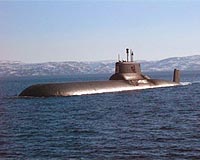 |
Moscow (UPI) Aug 20, 2010 While most Western navies have been fielding nuclear-powered submarines since the 1960s, diesel-powered models have after significant upgrades become significant naval vessels. The U.S. shut down its diesel submarine assembly lines in the 1960s since the U.S. Navy went nuclear, but other nations have retained the capacity to construct diesel submarines. Russia's Admiralteiskiye Verfi shipyard has laid down the keel of a Project 636.3 diesel-powered submarine (Kilo class), intended for the Black Sea Fleet, ITAR-Tass reported Friday. The NATO designation for the class is "Kilo." Admiralteiskiye Verfi's Director General Vladimir Alekhsandrov told journalists that the new Project 636 vessel has a low noise signature and a highly automated propulsion system married to significant missile and torpedo armaments. The Project 636, crewed by 52 submariners, has an underwater speed of 20 knots, a cruising range at a conservative deployment of 400 miles with the ability to patrol for 45 days. Specialists at the Rubin design bureau introduced modifications to a number of systems and equipment to adjust the vessel for operating in the Black Sea's unique conditions. Russian Navy chief Adm. Vladimir Vysotskii said the Russian Black Sea Fleet would eventually be equipped with three Project 636.3 diesel-electric submarines. Admiralteiskiye Verfi is the direct descendant of a shipyard founded in St. Petersburg in 1704 by Czar Peter the Great. Since then it has constructed more than 2,500 warships, submarines, merchantmen and research vessels. Besides domestic consumption, Russia's armaments export agency Rosoboronekhsport believes Project 636 has great export potential. In a June news release Rosoboronekhsport noted, "Russia's export potential in this market sector is very high thanks to Project 636 and Amur-1650 class submarines equipped with the Club-S integrated missile systems." The Project 636 Kilo-class submarine has been specifically designed for anti-shipping and anti-submarine operations in relatively shallow waters, where the longer endurance of nuclear-powered boats is a less significant factor. Rosoboronekhsport has already built Kilo-class submarines for India, China and Iran and projects sales of up to 40 fourth-generation diesel-electric submarines to foreign customers. In April Admiralteiskiye Verfi confirmed that it will build six Kilo-class diesel-electric submarines for Vietnam in a deal estimated to be worth $1.8 billion. Naval equipment now constitutes about 10 percent of Rosoboronekhsport's export portfolio, now estimated to be about $30 billion annually, second only to U.S. weaponry exports. At the International Naval Show-2009 in St. Petersburg Rosoboronekhsport delegation head Oleg Azizov stated, "By 2010, the share of naval equipment in Russia's arms exports will reach 15 percent, and by 2011 it will total 20 percent."
Share This Article With Planet Earth
Related Links Naval Warfare in the 21st Century
 Venezuela acquiring Russian submarines
Venezuela acquiring Russian submarinesCaracas, Venezuela (UPI) Aug 10, 2010 Venezuela is close to acquiring Russian submarines but President Hugo Chavez isn't giving anything away - yet. He told the audience of his populist Sunday political sermon on Venezuela's state-run radio and television the submarines that are about to join the country's armed forces would be "normal" submersibles with conventional weapons and radar technology. "They won't have a ... read more |
|
| The content herein, unless otherwise known to be public domain, are Copyright 1995-2010 - SpaceDaily. AFP and UPI Wire Stories are copyright Agence France-Presse and United Press International. ESA Portal Reports are copyright European Space Agency. All NASA sourced material is public domain. Additional copyrights may apply in whole or part to other bona fide parties. Advertising does not imply endorsement,agreement or approval of any opinions, statements or information provided by SpaceDaily on any Web page published or hosted by SpaceDaily. Privacy Statement |